Take a moment to imagine with me. You are a Civil War soldier. You’ve been marching for days, having left one battlefield and on your way to the next. You’re cold, tired, and emotionally beat. When you finally stop and setup camp, you sit and talk with your brothers in arms, little about the war, and a lot about home. The coffee rations have been long used up, if you had any to begin with, yet you long for something, anything, to ground you in that longing. Acorns are picked whenever the men had the chance to stop near an old oak; likely risking their life to do so. Now each man throws in his share. They are split and roasted over the coals as the conversations continue, and before too long, they are ground, boiled, and served hot. It isn’t coffee, but that’s alright. This isn’t home.
This is the kind of setting that goes through my mind when thinking about the ways in which men had to live back when. Without a doubt, my imagination adds color to the scene which would otherwise be simply, “That’s just the way it was…” to those men. But, I enjoy connecting in some way with the past, and food is one of my favorite ways of doing that.
I supposed that acorn coffee must be awful, since no one drinks it anymore — at least no one that I know. However, I have been off coffee for a few months now, and while I feel better, I miss it sometimes. So, I had a reason for wanting to try some sort of coffee substitute, and, as it turns out, acorn coffee is not bad; not bad at all. I actually enjoy it quite a bit. The final result has an earthy, nutty, charred aroma, not unlike coffee, with chocolate undertones. At least, these are the impressions people gave it when I had them smell the acorn coffee without knowing what it was.
Here is a simple guide on how to make your own acorn coffee. But, since you can’t just go to the store and grab a bushel of acorns, it is important to know a bit about the oak trees and the acorns you are searching for in order to have the best results.
Not All Acorns are the Same
If you are a hunter there is a good chance you know something about acorns. Deer, squirrel, hogs, and other tasty woodland creatures love acorns, but they, like us, have their preferences. Oak trees are divided into two types, White Oaks and Red Oaks, with animals preferring the white oaks, and for good reason. All acorns have a bitter coating of tannin, though white oaks have far less than red. In preparation for the winter, squirrels will typically eat white oak acorns and bury the red oak acorns. The process of leaving them underground for several months leaches out a good deal of the tannin. Humans typically boil red oak acorns, sometimes several times, to remove the tannin. In fact, the brown substance that is left over from the boiling is what was used to “tan” hides. It was used for tanning (tannin’) so it got the name.
It is easy to tell white from red oaks: white oak leaves have rounded lobes whereas the red oak leaves end in a point.
There is another way to tell whether or not an acorn has a little or a lot of tannin and that is the proportion of the acorn top to the nut. Red oak acorns have larger tops than white oak acorns, but not all red or white oak varieties have the same. When making food from the mast (acorns, hickory nuts, and chestnuts when they were around) of the forest you want to seek out the largest you can find with the least amount of tannin. The pictures below will help illustrate this.
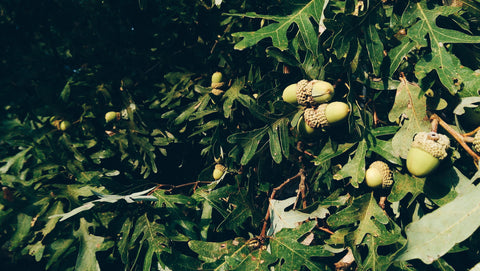
A large white oak tree with large acorns. Notice the rounded ends of the leaves and the ratio of acorn to acorn top.
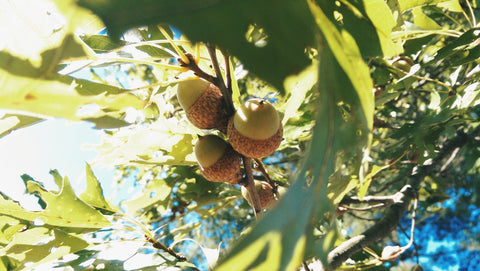
A red oak tree with acorns. It is a little hard to see, but the tips of the leaves are pointed. Notice, also, how the acorns have “caps” instead of tops. You can be sure these have a lot of tannin. Great for tanning leather, not great for eating if you have an alternative.
How to Make Acorn Coffee
While you can pick acorns off the ground, there is a good chance worms or squirrels will have gotten to them first. It is best if you can find a mature white oak where the branches hang low and the acorns can be picked by hand.
Step 1: Pick the Acorns
Start scouting for just the right oak tree a few weeks before fall. You will be able to see which oak has the biggest crop and may even be able to pick the acorns while they are green.
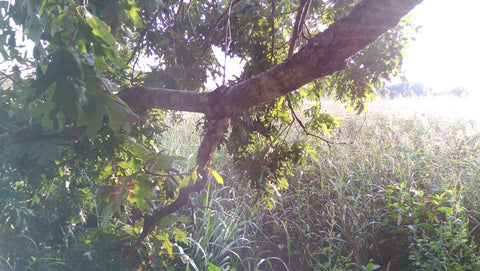
A low branch of an old white oak tree where I get my acorns. White oaks are great because they produce every year whereas red oaks are bi-annual. This old branch is seeking home in the ground, and when it finds it, will start a new root system from which new oaks will sprout.
Step 2: Let the acorns “ripen” in a paper bag
If you pick your acorns green, but close to the fall season, you can let them “ripen” or “brown” in a paper bag. This may take a week or more. I used a standard grocery bag and kept them in a cool place in the house.
This step is also important if your acorns are already brown, as it allows them to dry out a bit and pull away from their shell, which makes the next step easier.
Step 3: Inspect and Boil the acorns in the shell
Before boiling the acorns it is a good idea to inspect them for signs of worm holes. The worms are fine to eat, but they are usually a sign of a ruined acorn. Discard any “suspect” acorns.
Boil the acorns for about 30 minutes. This is simply to make the outside shell more pliable which helps in the next step.

This acorn has definitely had a worm inside.
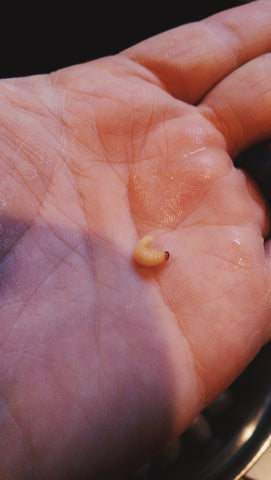
This little guy was still wiggling around in my acorn bag after sitting a few weeks. I guess he had a good meal.

These acorns are ready for boiling.
Step 4: Shell and Peel the acorns
This step takes the longest amount of time. Thankfully, I had my son Harvey give me a hand. It was a good time to shell, peel, and talk, which reminded me of hulling peas and shucking corn with the family when I was a boy.
After the acorns have cooled down a bit from the previous step, use a serrated knife to cut the acorn in half. The serrations keep the acorns from slipping. I used my pocket knife for this, a Leatherman c33X, but any serrated kitchen knife will do.
Sometimes the acorn will fall right out, but usually fingernails have to be used.
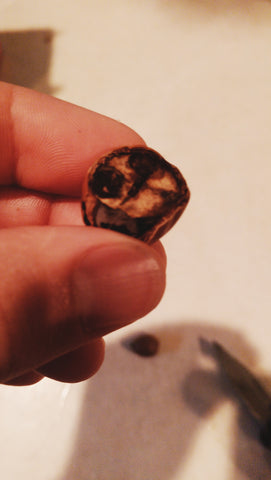
This acorn is bad. Toss it in the trash!
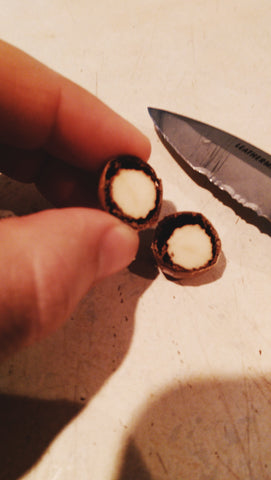
This is how an acorn should look. The white part is the meat, or nut meat of the acorn and is what we are after.
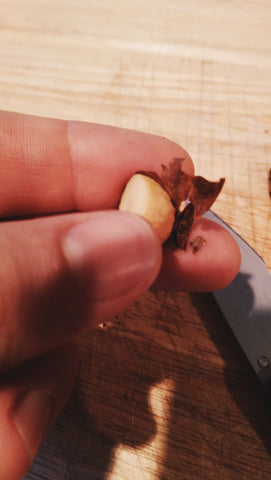
After shelling the acorn you’ll want to get as much of this skin off as possible. This is the source of the tannin and will result in a bitter taste if you leave it on.
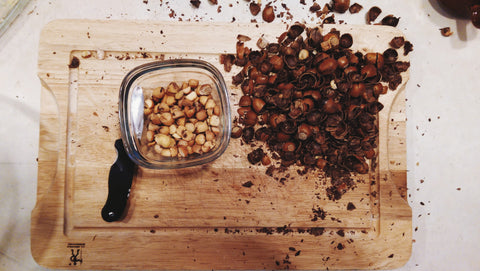
A batch of acorns, shelled and ready for the food processor.
Step 5: Into the food processor
Use a food processor to chop up the acorns.
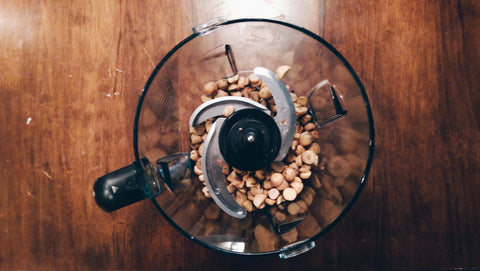
Acorns in the food processor. Blend until they are small pieces.
Step 6: Boil the acorn pieces (optional)
If you are using red oak acorns, you definitely need to do this step. However, with white oak acorns it can probably be skipped.
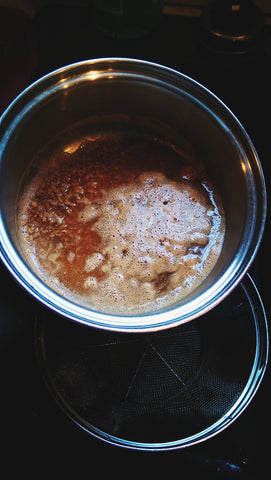
Acorns after being boiled. Run cold water over them and repeat as necessary until the water is sufficiently clear.
Step 7: Roast the acorns
Spread the acorns out on a pan lined with aluminum foil. The foil makes it easier to transfer the acorns to the coffee grinder in the next step.
I roasted my acorns at 400 F for about 35 minutes on the lowest rack, stirring them around occasionally. You can tell when they are good when they are black and begin to smoke. You might want to test with smaller batches first.
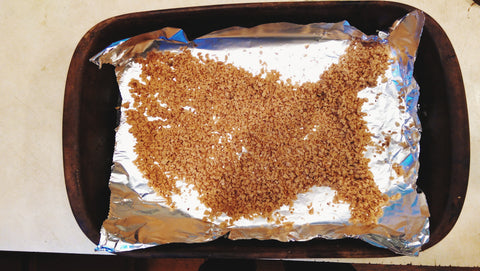
Acorns ready for the oven. I decided to spread them out in the shape of my beloved country, because, Merica’.
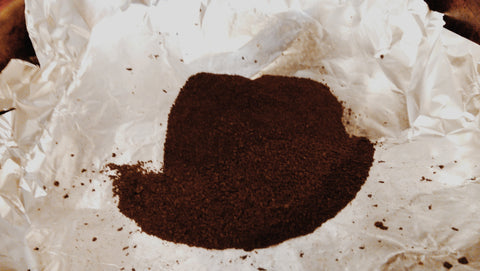
This picture is slightly deceptive. After roasting them to a medium-darkness, I ground them and decided to put them back in the oven. This is the result. I should have just left them in longer.
Step 8: Grind the acorns in a coffee grinder
Using a corse-grind setting, grind the acorns.

Acorns in a hand grinder.
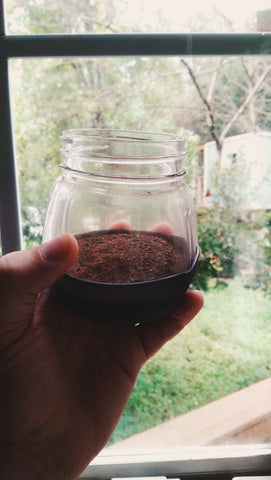
The resulting amount of acorn coffee is rather disappointing, but tasty none the less.
Step 9: Make acorn coffee
Finally, we are at the last step. The recipe for acorn coffee is very similar to that of regular coffee, but I found it better to use more acorns or less water than typical. If you use more water or less acorns then you will have something like a tea, which is actually quite good as well.
I chose to use a French press rather than a drip coffee maker, mainly so that I could control the process and get the best result. I imagine a pour-over would work as well.
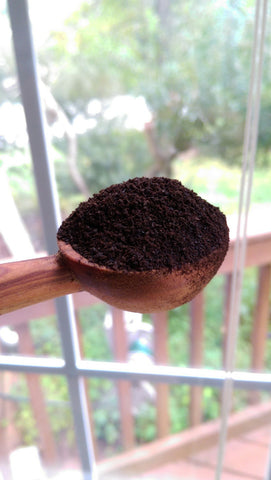
Use a heaping tablespoon of acorn coffee grounds for every 6 oz of water.
Step 10: Drink and enjoy!
This is the best part! Throughout this process you probably noticed the wonderful smell of roasted acorns. The good news is that it taste pretty much as it smells. The result is a smooth and nutty cross between coffee and tea.
Being that it was a unique opportunity, and since Harvey helped with the shelling, I thought it appropriate to have a cup with him.

Harvey having his first taste of acorn coffee.

Here I am about to have my first taste. A lot of work went into getting this coffee.
Final Thoughts
I will admit I am probably biased towards this drink. After being off of coffee for some time and working as hard as I did to make the acorn coffee, there is a good chance I was going to enjoy it no matter what. So, after having a few cups of on my own, I took a bit to one of my favorite baristas to get his opinion. He made it a little weak (he said so himself) so it ended up being more like a tea, but he said he liked it, and I don’t think he was lying.
Harvey said, “If I were a Civil War soldier, and had a mix of blood and bile in my mouth, this stuff would almost pass for coffee.” I don’t think he was lying either!
While there is no substitute for coffee, there is also no substitute for enjoying an organic, free, seasonal drink that you produced with your own hands. Acorn coffee is a rare cup of brew indeed, one that I plan on enjoying each fall. If you are interested in making a cup, you best get out there and get your acorns before the squirrels, deer, and Sasquatch beat you to them.

